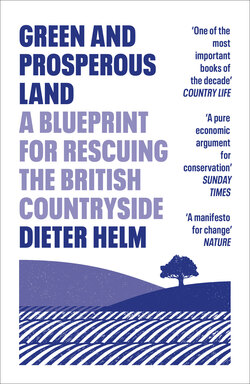Green and Prosperous Land

Реклама. ООО «ЛитРес», ИНН: 7719571260.
Оглавление
Dieter Helm. Green and Prosperous Land
GREEN AND PROSPEROUS LAND
Dieter Helm
Copyright
Praise for Green and Prosperous Land
Dedication
Epigraph
PREFACE
LIST OF ABBREVIATIONS
Introduction. OUR NATURAL CAPITAL INHERITANCE
1. THE PRIZE
No more declines
Enhancements
2. BUSINESS-AS-USUAL
A damaged inheritance
More declines
What is coming next
More people
More houses
More infrastructure
More consumption
An even quieter spring?
3. RESTORING RIVERS
Protecting the upper rivers
Stopping farm pollution
Dealing with the industrial legacy
The water companies
Towns, housing, roads and sustainable drainage systems
Putting it all together: Coordinating catchments
4. GREEN AGRICULTURE
How we got into this mess
The crazy economics of British farming
The benefits of a green countryside
Anew sustainable and prosperous agriculture and agricultural policy
Wildlife corridors
Food production and self-sufficiency
A better agricultural sector and countryside
5. THE UPLANDS
The rewilding fallacy
Sheep and the uplands
The deer problem
Game shooting
Other game and their consequences
The National Parks
Public benefits in the uplands
The upland population
Managing the land for people, wildlife and carbon
6. THE COASTS
The coastal fringe
The beaches and marshes at the sea edges
The estuaries
The coastal waters
The islands
Returning the coast and the seas to good health – and increasing prosperity
A fishing policy fit for purpose
The regulation of fish farming
Habitat restoration
Eradication of alien species from islands, and biosecurity measures
A sustainable approach to tourism with no net environmental losses
The coastal prize in 2050
7. NATURE IN THE TOWNS AND CITIES
Clean air
Natural capital solutions
Greener streets and greener roofs
Urban water quality and sewerage
Nature in the city
The new green spaces
Urban green corridors– connecting networks of green highways
The outer rings–the Green Belt and what it could be
A biodiverse and green urban environment
8. PUBLIC GOODS
What is a public good?
Public goods, ecosystems and coordination
What are the most important public goods?
Which should we spend what on?
Filling in the details
Richer and greener public spaces
9. PAYING FOR POLLUTION
The polluter-pays principle
Putting a price on pollution
Pricing pollution and the money
Fines for pollution
Net environmental gain and developers
Subsidies
Other perverse farming subsidies–inheritance tax, fuel duties and rates
Perverse subsidies in industrial policy and infrastructure
The great improvements that come from proper economics
10. NATURAL CAPITAL MARKETS, AUCTIONS AND THE NET ZERO EXAMPLE
What net zero really means
The natural way
Paying for carbon sequestration
Timescales
End of life of the trees – storing the carbon
Establishing natural capital baselines
Working out enhancements
Credibility, bankability and finance
11. A NATURE FUND
Redirecting current spending
Adding in the value of pollution taxes
Adding in the net environmental gain compensation payments
Adding in the avoided perverse subsidies beyond the CAP
Separating spending from revenues
Looking after the future
Designing a Nature Fund
The Nature Fund budget
Owning assets
Deciding how to spend the money
12. THE PLAN
Why we need a top-down plan
The European and global dimensions
How do the bits fit together?
The accounting basis and metrics
How do we prioritise?
Revising the plan
Big data, GPS and genomics
Embedding the plan
Making governments stick to the plan
Conclusions. SECURING THE PRIZE
ENDNOTES
BIBLIOGRAPHY
INDEX
ACKNOWLEDGEMENTS
About the Author
About the Publisher
Отрывок из книги
A BLUEPRINT FOR RESCUING THE BRITISH COUNTRYSIDE
‘Helm’s solutions are refreshingly straightforward … The notion of the financial value of nature is long established. Helm takes this further to present a pure economic argument for conservation. We all need to listen to that’ Simon Barnes, Sunday Times
.....
The 25 Year Environment Plan needs to integrate the principles behind it into the fabric of the economy and government. These are the two aims of the earlier 2011 White paper, ‘The Natural Choice’:[8] putting the environment at the core of the economy; and leaving the natural environment in a better state for the next generation. Although much may be achieved immediately and a number of reforms will help us along this path, to stand the test of economic crises and recessions and the sheer power of the hostile lobbyists, there needs to be an overarching legal and constitutional framework. As with climate change, politicians are good at the rhetoric, and they may well mean what they say, but permanently delivering it requires something more. The 2008 Climate Change Act changed the game. It is very hard to get out of its targets and the carbon budgets. We need something similar, a proper Nature Act that enshrines the principles in the 2011 White Paper and the 25 Year Environment Plan.
There is a choice: we can impoverish ourselves by continuing down the current path, or we can have a greener and more prosperous land, and one that is pleasanter too. The book concludes with this choice.
.....